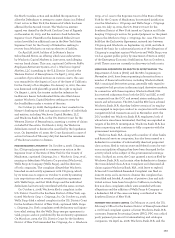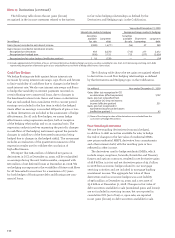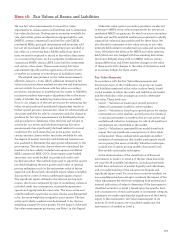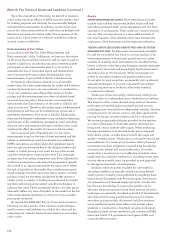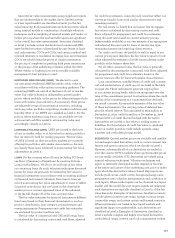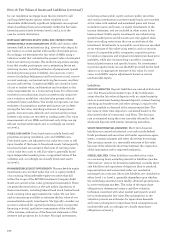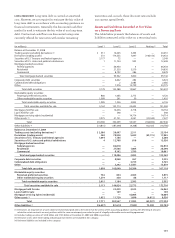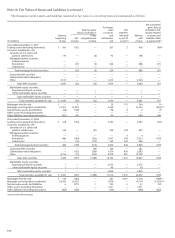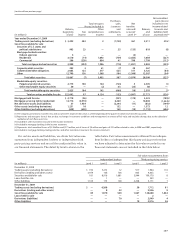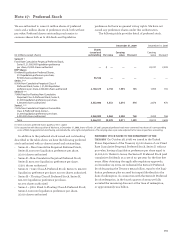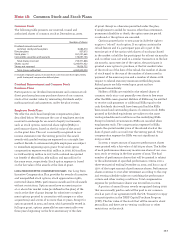Wells Fargo 2009 Annual Report Download - page 155
Download and view the complete annual report
Please find page 155 of the 2009 Wells Fargo annual report below. You can navigate through the pages in the report by either clicking on the pages listed below, or by using the keyword search tool below to find specific information within the annual report.
Security fair value measurements using significant inputs
that are unobservable in the market due to limited activity
or a less liquid market are classified as Level 3 in the fair
value hierarchy. Such measurements include securities valued
using internal models or combination of multiple valuation
techniques such as weighting of internal models and vendor or
broker pricing, where the unobservable inputs are significant
to the overall fair value measurement. Securities classified
as Level 3 include certain residential and commercial MBS,
asset-backed securities collateralized by auto leases or loans
and cash reserves, CDOs and CLOs, and certain residual and
retained interests in residential mortgage loan securitizations.
CDOs are valued using the prices of similar instruments,
the pricing of completed or pending third party transactions
or the pricing of the underlying collateral within the CDO.
Where vendor or broker prices are not readily available,
management’s best estimate is used.
MORTGAGES HELD FOR SALE (MHFS) We elected to carry
our new prime residential MHFS portfolio at fair value in
accordance with fair value option accounting guidance. The
remaining MHFS are carried at the lower of cost or market
value. Fair value is based on independent quoted market
prices, where available, or the prices for other mortgage whole
loans with similar characteristics. As necessary, these prices
are adjusted for typical securitization activities, including
servicing value, portfolio composition, market conditions and
liquidity. Most of our MHFS are classified as Level 2. For the
portion where market pricing data is not available, we use
a discounted cash flow model to estimate fair value and,
accordingly, classify as Level 3.
LOANS HELD FOR SALE (LHFS) LHFS are carried at the lower
of cost or market value, or at fair value for certain portfolios
that we intend to hold for trading purposes. The fair value
of LHFS is based on what secondary markets are currently
offering for portfolios with similar characteristics. As such,
we classify those loans subjected to nonrecurring fair value
adjustments as Level 2.
LOANS For the carrying value of loans, including PCI loans,
see Note 1 (Summary of Significant Accounting Policies –
Loans) in this Report. We do not record loans at fair value
on a recurring basis. As such, valuation techniques discussed
herein for loans are primarily for estimating fair value for
financial instruments in accordance with accounting guidance
on financial instruments. However, from time to time, we
record nonrecurring fair value adjustments to loans to reflect
(1) partial write-downs that are based on the observable
market price or current appraised value of the collateral,
or (2) the full charge-off of the loan carrying value.
The fair value estimates for financial instruments differen-
tiate loans based on their financial characteristics, such as
product classification, loan category, pricing features and
remaining maturity. Prepayment and credit loss estimates
are evaluated by product and loan rate.
The fair value of commercial and CRE and foreign loans
is calculated by discounting contractual cash flows, adjusted
for credit loss estimates, using discount rates that reflect our
current pricing for loans with similar characteristics and
remaining maturity.
For real estate 1-4 family first and junior lien mortgages,
fair value is calculated by discounting contractual cash
flows, adjusted for prepayment and credit loss estimates,
using discount rates based on current industry pricing
(where readily available) or our own estimate of an appropriate
risk-adjusted discount rate for loans of similar size, type,
remaining maturity and repricing characteristics.
For credit card loans, the portfolio’s yield is equal to our
current pricing and, therefore, the fair value is equal to book
value adjusted for estimates of credit losses inherent in the
portfolio at the balance sheet date.
For all other consumer loans, the fair value is generally
calculated by discounting the contractual cash flows, adjusted
for prepayment and credit loss estimates, based on the
current rates we offer for loans with similar characteristics.
Loan commitments, standby letters of credit and commer-
cial and similar letters of credit are not included in the table
on page 160. These instruments generate ongoing fees
at our current pricing levels, which are recognized over the
term of the commitment period. In situations where the credit
quality of the counterparty to a commitment has declined,
we record a reserve. A reasonable estimate of the fair value
of these instruments is the carrying value of deferred fees
plus the related reserve. This amounted to $725 million at
December 31, 2009, and $719 million at December 31, 2008.
Certain letters of credit that are hedged with derivative
instruments are carried at fair value in trading assets or
liabilities. For those letters of credit fair value is calculated
based on readily quotable credit default spreads, using
a market risk credit default swap model.
DERIVATIVES Quoted market prices are available and used for
our exchange-traded derivatives, such as certain interest rate
futures and option contracts, which we classify as Level 1.
However, substantially all of our derivatives are traded in
over-the-counter (OTC) markets where quoted market prices
are not readily available. OTC derivatives are valued using
internal valuation techniques. Valuation techniques and
inputs to internally-developed models depend on the type
of derivative and nature of the underlying rate, price or index
upon which the derivative’s value is based. Key inputs can
include yield curves, credit curves, foreign-exchange rates,
prepayment rates, volatility measurements and correlation of
such inputs. Where model inputs can be observed in a liquid
market and the model does not require significant judgment,
such derivatives are typically classified as Level 2 of the fair
value hierarchy. Examples of derivatives classified as Level 2
include generic interest rate swaps, foreign currency swaps,
commodity swaps, and certain option and forward contracts.
When instruments are traded in less liquid markets and
significant inputs are unobservable, such derivatives are
classified as Level 3. Examples of derivatives classified as
Level 3 include complex and highly structured derivatives,
credit default swaps, interest rate lock commitments written




